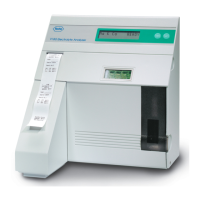Roche Diagnostics
Instructions for Use · Version 10.0 141
9180 Electrolyte Analyzer 9 Maintenance
Annual maintenance
Annual maintenance
Exchanging main tubing harness
q
It is recommended to replace the sample probe and the fill port at the same time as the
main tubing harness is replaced (see Replacing sample probe and fill port (p. 147)).
NOTICE
Failure to annually replace the main tubing harness may lead to leaks in the tubing
system
Continued use of the 9180 Electrolyte Analyzer without replacing the main tubing
harness at least once a year may lead to leaks in the tubing system. This may result in
malfunction and/or damage to the analyzer.
r Replace the main tubing harness at least once a year.
WARNING
Inappropriate handling and disposal of the main tubing harness may cause
infection and environmental harm
The main tubing harness may contain liquid and/or solid waste. Inappropriate handling of
this waste during disposal may lead to the transmission of blood or urine borne pathogens.
In addition, inappropriate disposal may contaminate the environment.
r Treat the main tubing harness as biohazardous waste and dispose it according to the
local regulations. For more information, contact your Roche Service representative.
r Take extra care when working with protective gloves. They can easily be pierced or cut,
leading to infection.
r Wear appropriate personal protective equipment.
r If any biohazardous material is spilled, wipe it up immediately and apply a disinfectant.
r If waste comes into contact with your skin, wash the affected area immediately with
soap and water and apply a disinfectant. Consult a physician.
WARNING
Risk of instrument damage or wrong results due to ESD discharge
Considerable electrostatic discharge can be emitted from contacting the metallic
components of the analyzer.
r Do not remove any cover of the analyzer except those covers specified in the
instructions.
r If it is probable that you will come into contact with metallic components of the
analyzer, touch the discharge point of the analyzer (see Analyzer components (p. 69))
before performing any action on the analyzer.
o At the READY screen, press NO until SERVICE FUNCTIONS? appears, and
press YES.
o Press NO until Test Pinch Valves? appears. Press YES.
o Remove the valve caps and slide them in the direction of the arrow.
o Then, remove the pinch bars.
q
Each valve consists of a solenoid coil inside the analyzer, a pinch bar and a valve cap.
To determine where the valves have to be positioned, see the tubing diagram on the
inside of the front door of the analyzer.

